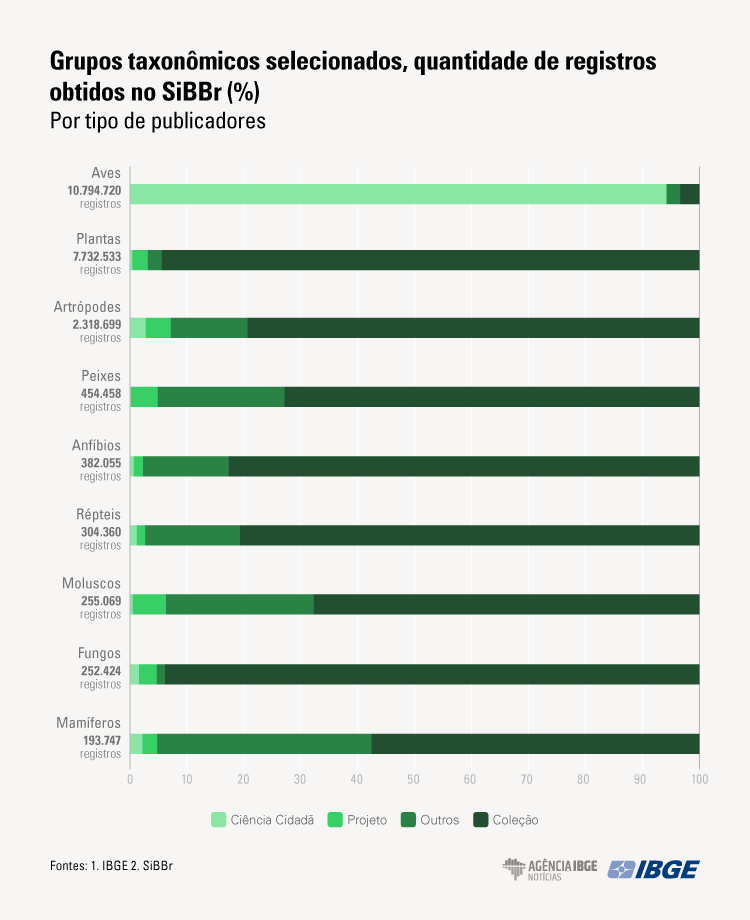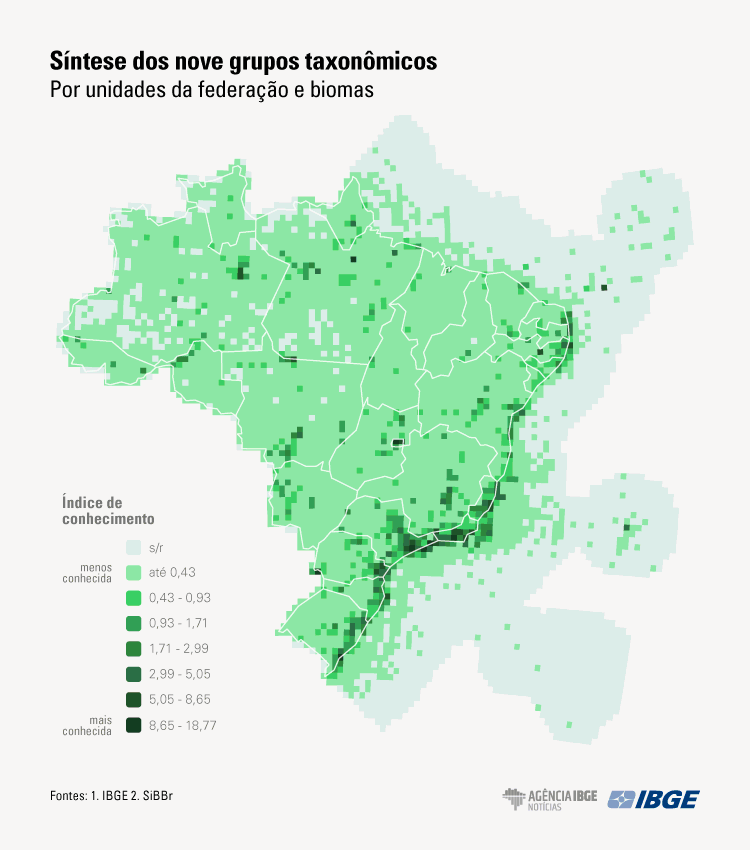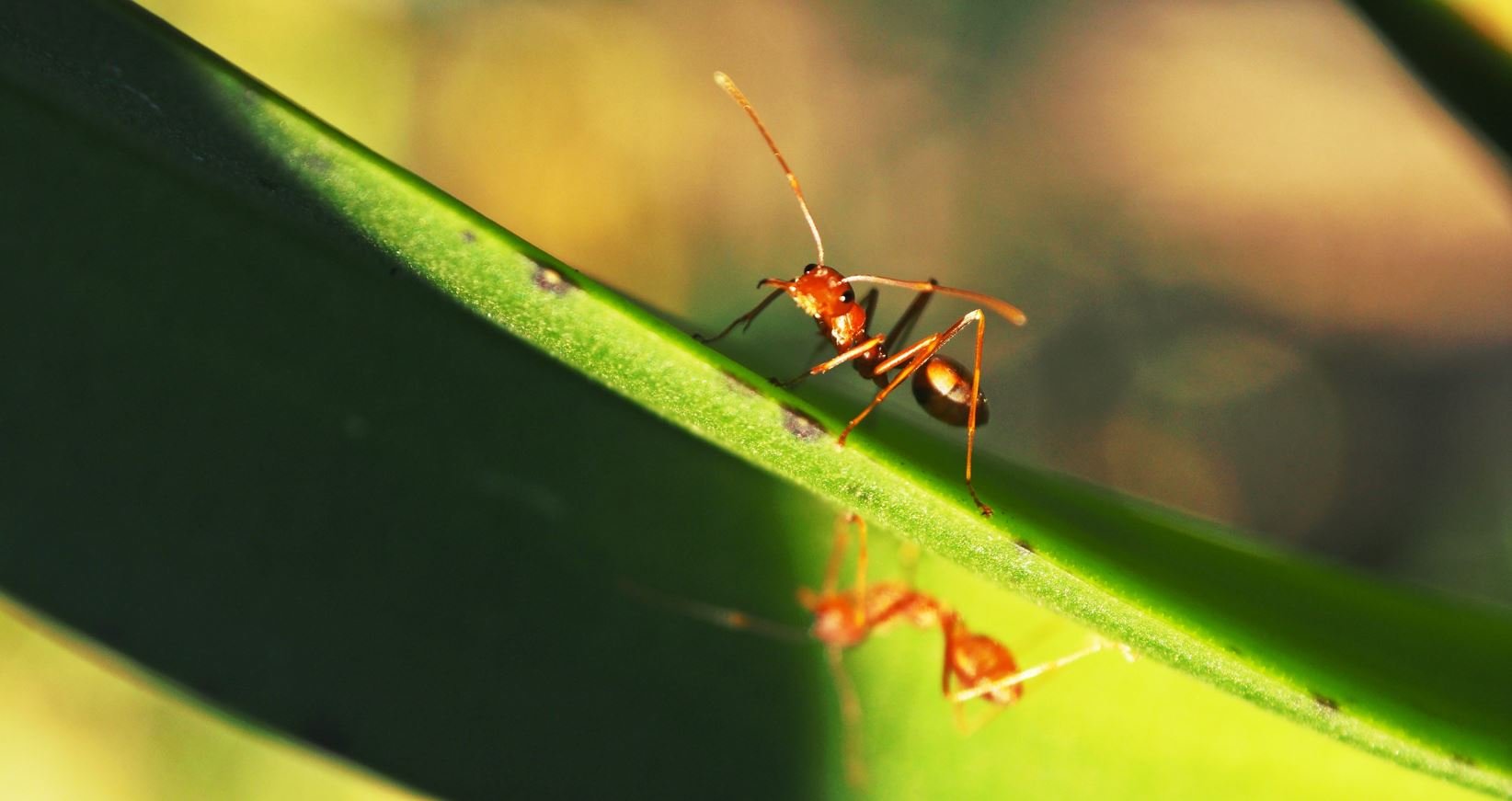IBGE evaluates data records on Brazilian biodiversity in SiBBr
Highlights
- IBGE publishes an assessment of available data on Brazilian biodiversity found in the Brazilian Biodiversity Information System (SiBBr) in 2022.
- SiBBr is coordinated by the Ministry of Science, Technology and Innovation (MCTI) and operated by the National Education and Research Network (RNP), and is part of the Global Biodiversity Information Facility (GBIF). The platform's target audience is mainly made up of researchers, students and government agencies.
- More than 22.5 million records of fauna and flora occurrence were analyzed, from various sources. The taxonomic groups analyzed were: amphibians, arthropods, birds, fungi, mammals, molluscs, bony fish, vascular plants and reptiles.
- Indicators on the quantity, age and representativeness of records were mapped across the country. With the exception of birds, the number of records with information considered complete (with date, geographic coordinates and species identification) does not reach 30%.
- Birds and plants stood out in the number of records and their distribution in the different sections analyzed. Arthropods, molluscs and fungi are less represented.
- Biological Collections was the category with the largest number of distinct publishers in SiBBr. The largest volume of records was observed in the Citizen Science category.
- The main limitations found in the data were the absence of geographic coordinates and the lack of detailed information on species identification. Despite this, the proportion of more complete records has increased in recent years.
- There was a big difference in the number of records between the Federation Units and geographic regions. There is also a significant contrast in the amount of biodiversity records between cells located at sea and on land.
- Around 81% of marine cells and 6% of terrestrial cells have no record of occurrence.
- Most records in SiBBr are 10 years old or less, which reflects an increasing trend in data production. This is due, among other things, to the fact that data georeferencing has become a more accessible resource.
IBGE made available, as of 11/22, an evaluation of existing data on biodiversity in Brazil in 2022. The unprecedented study mapped in a statistical grid the records of the occurrence of fauna and flora from different sources, inserted in the Brazilian Biodiversity Information System (SiBBr). The taxonomic groups analyzed were: amphibians, arthropods, birds, fungi, mammals, molluscs, bony fish, vascular plants and reptiles. Brazil is among the 17 countries that are home to more than 70% of the known species on the planet, but there is still much to discover and catalogue.
As this is an experimental investigation, improvements will be made based on user feedback. This publication is, therefore, an invitation to readers interested in the topic to return to IBGE their perceptions, criticisms and suggestions, which can be made through the Institute's official Customer Service Channel.
SiBBr, a federal government platform managed by the Ministry of Science, Technology and Innovation (MCTI), was created in 2014 with the function of storing and making information available about Brazilian biodiversity and ecosystems. The tool provides subsidies to public bodies aimed at conservation and sustainability. National teaching and research institutions, public or private, research projects and programs and thematic networks are the main data providers for SiBBr.
The System is part of the Global Biodiversity Information Facility (GBIF), a multilateral initiative with approximately 60 countries. “There is a very large demand, inside and outside Brazil, for information on national biodiversity. The objective of the study was to evaluate the data set available in SiBBr, identifying gaps and limitations in the data. IBGE's mission is to portray Brazil, and biodiversity is a fundamental part of that portrait. In addition to contributing to SiBBr through the biological collections maintained by IBGE, we have also sought to advance the production of statistics”, explains Leonardo Bergamini, Biodiversity analyst at IBGE.
“For SiBBr, evaluation by institutions such as IBGE is important. It is a way to correct any problems and make improvements to the platform, improving the quality of the data”, adds Keila Juarez, specialist in Biodiversity Information at SiBBr.

With the exception of birds, the number of records with complete information is less than 30%
Data publishers were divided into four categories: Citizen Science (records published by a community of users), Biological Collections (repositories of organisms or samples organized for scientific purposes), Research Projects or Programs (results of scientific research) and Others (do not fall into any of the aforementioned categories).
In the groups analyzed, with the exception of birds, the number of records with complete information does not reach 30% of the total available data. Birds and plants, the groups most easily detected and collected, had a greater number and better distribution of records, while arthropods, molluscs and fungi had a less representative sample.
Information coming from Biological Collections formed the most frequent publisher category on SiBBr, followed by Projects and Others. The Citizen Science category contained the largest volume of records, especially birds, even with just three publishers. The main limitations of the dataset are the lack of geographic coordinates and the lack of detail in identifying recorded species, but the proportion of more complete records has been increasing.
Differences in research infrastructure accentuate inequalities in scientific production
Regional disparities in record density were observed. Differences in research and documentation infrastructure, in addition to the concentration of scientific institutions such as universities and museums, are possible explanations. São Paulo, Distrito Federal and Rio de Janeiro were the Federation Units with the largest number of collections and records, as well as the highest densities. The states in the Northeast, in turn, had the lowest number of records, and those in the North showed the lowest densities.
There was a significant difference in the records of sea cells and land cells, which are more studied and documented. Approximately 81% of marine cells have no record of occurrence, while among terrestrial cells this rate is around 6%. This difference may be due to the greater difficulty of access and operational costs of marine research.
Most existing records in SiBBr are recent (up to 10 years old). This is the result of an increase in data production in recent years and the greater ease with which it can be georeferenced.

Clara Fonseca, Business Analyst at SiBBr, reinforces the relevance of partnerships such as that between IBGE and SiBBr in disseminating knowledge about biodiversity in the country. “We need more people to know about SiBBr, so that the data can be used by society in public policies to preserve the environment. The more visibility the System has, the greater the number of researchers encouraged to publicize their discoveries”, she recalls.
“There are many studies that evaluate databases, but most of them analyze specific groups. One of the differences in this research is the fact that we are working with the entire country, covering nine taxonomic groups, spatial and temporal information. Our intention is to identify the problems, understand what we have and what can be improved”, observes Mariza Pinheiro, Biodiversity analyst at IBGE.
FONTE: IBGE - Igor Ferreira | Arte: Brisa Gil
